Greenhouse Effect 101
By increasing the concentration of greenhouse gases in the atmosphere, we’re amplifying the planet’s natural greenhouse effect and turning up the dial on global warming.
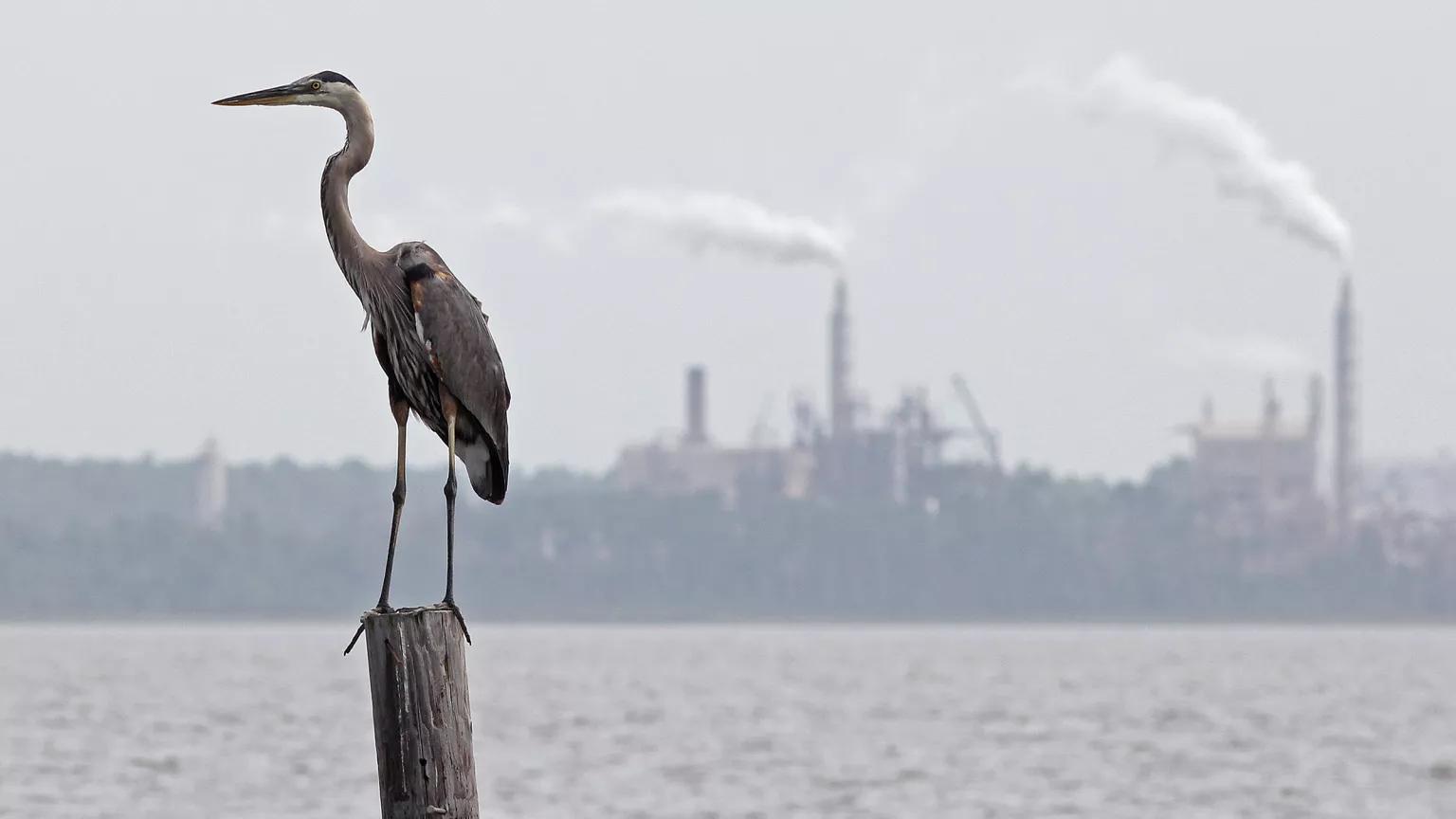
Dan Mooney via Flickr
The greenhouse effect is a good thing. It warms the planet to temperatures that keep life on earth, well, livable. Without it, the world would be more like Mars: a frozen, uninhabitable place. The problem is, the voracious burning of fossil fuels for energy is artificially amping up the natural greenhouse effect. The result? An increase in global warming that is altering the planet’s climate system. Here’s a look at what the greenhouse effect is, what causes it, and how we can temper its contributions to our changing climate.
What is the greenhouse effect?
The greenhouse effect is the natural warming of the earth that results when gases in the atmosphere trap heat from the sun that would otherwise escape into space. The process was identified by scientists in the 1800s.
What causes the greenhouse effect?
Sunlight, with the natural greenhouse effect process, makes the earth habitable. While around 30 percent of the solar energy—the light and heat from the sun—that reaches our world is reflected back into space, the rest is either absorbed by the atmosphere or the earth’s surface. This process, which is constantly happening around the globe, warms the planet. This heat is then radiated back up in the form of invisible infrared radiation. While some of this infrared light continues on into space, the vast majority gets absorbed by atmospheric gases, known as greenhouse gases, causing further warming.
But higher concentrations of greenhouse gases, and carbon dioxide (CO2) in particular, are causing extra heat to be trapped and average global temperatures to rise. For most of the past 800,000 years—much longer than human civilization has existed—the concentration of CO2 in our atmosphere was roughly between 200 and 280 parts per million. (In other words, there were 200 to 280 molecules of the gases per million molecules of air.) But in the past century, that concentration has jumped. In 2013, driven up largely by the burning of fossil fuels and deforestation, CO2 in the earth’s atmosphere surpassed 400 parts per million—a concentration not seen on the planet for millions of years. As of 2023, it has reached more than 420 parts per million, which is 50 percent higher than preindustrial levels.
What are greenhouse gases?
Earth’s greenhouse gases trap heat in the atmosphere and warm the planet. The main gases responsible for the greenhouse effect include carbon dioxide, methane, nitrous oxide, and water vapor. In addition to these natural compounds, synthetic fluorinated gases also function as greenhouse gases. Different greenhouse gases have different chemical properties and are removed from the atmosphere, over time, by various processes. Carbon dioxide, for example, is absorbed by “carbon sinks” such as forests, soil, and the ocean. Fluorinated gases are only destroyed by sunlight in the far upper atmosphere.
How much any one greenhouse gas influences global warming depends on three key factors:
- How much of the gas exists in the atmosphere. Concentrations are measured in parts per million (ppm), parts per billion (ppb), or parts per trillion (ppt). For example, 1 ppm for a given gas means that there is one molecule of that gas in every one million molecules of air.
- How long the gas remains in the atmosphere, otherwise known as its lifetime.
- How effective the gas is at trapping heat. This is referred to as its global warming potential (GWP) and is a measure of the total energy that a gas absorbs over a given period of time (usually 100 years) relative to the emissions of 1 ton of carbon dioxide.
Radiative forcing (RF) is another way to measure greenhouse gases (and other climate drivers, such as the sun’s brightness and large volcanic eruptions). Also known as climate forcing, RF indicates the difference between how much of the sun’s energy gets absorbed by the earth and how much is released into space as a result of any one climate driver. A climate driver with a positive RF value indicates that it has a warming effect on the planet; a negative value represents cooling.
What are greenhouse gas emissions?
The release of greenhouse gases associated with human activities and climate change is referred to as greenhouse gas emissions, or climate pollution. And since the start of the Industrial Revolution and the advent of coal-powered steam engines, human activities have supersized the volume of greenhouse gases emitted into the atmosphere. It is estimated that between 1750 and 2019, atmospheric concentrations of carbon dioxide increased by 47 percent, methane by 156 percent, and nitrous oxide by 23 percent. In the late 1920s, we started adding man-made fluorinated gases like chlorofluorocarbons to the mix.
In recent decades, we’ve only picked up the pace. Of all the human-driven emissions of carbon dioxide, approximately half were generated in the last 30 years alone. And while global greenhouse gas emissions have occasionally plateaued or dropped from year to year (most recently at the start of the COVID-19 pandemic, as the pause in global travel and manufacturing dropped carbon dioxide emissions almost 6 percent), they’re accelerating once again.
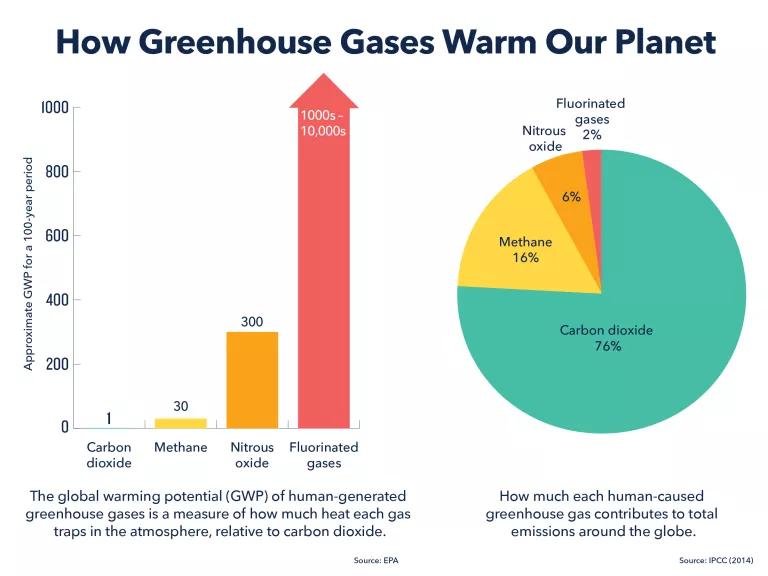
Five major greenhouse gases
The most significant gases that cause global warming via the greenhouse effect are the following:
Carbon dioxide
Accounting for almost 80 percent of global human-caused emissions, carbon dioxide sticks around for quite a while. Once it’s emitted into the atmosphere, 40 percent still remains after 100 years, 20 percent after 1,000 years, and 10 percent as long as 10,000 years later. (Carbon dioxide’s lifetime cannot be represented with a single value because the gas is not destroyed over time, but instead moves among different parts of the ocean, atmosphere, and land. Some carbon dioxide is absorbed quickly, but some will remain in the atmosphere for thousands of years.)
Methane
Methane (CH4) persists in the atmosphere for around 12 years, which is less time than carbon dioxide, but it is much more potent in terms of the greenhouse effect. In fact, pound for pound, its global warming impact is almost 30 times greater than that of carbon dioxide over a 100-year period. In the United States, according to the U.S. Environmental Protection Agency (EPA), methane accounted for more than 12 percent of human-generated greenhouse gas emissions in 2021. While methane can come from natural sources like wetlands, more than half of all global methane emissions come from human activities like natural gas production and livestock-based agriculture.
Nitrous oxide
Nitrous oxide (N2O) is a powerful greenhouse gas: According to the EPA, it has a GWP that is around 270 times that of carbon dioxide on a 100-year time scale, and it remains in the atmosphere, on average, a little more than a century. The EPA estimates that it accounts for about 6 percent of human-caused greenhouse gas emissions in the United States, from sources like the fertilizers used in agriculture.
Fluorinated gases
Emitted from a variety of manufacturing and industrial processes, fluorinated gases are man-made. There are four main categories: hydrofluorocarbons (HFCs), perfluorocarbons (PFCs), sulfur hexafluoride (SF6), and nitrogen trifluoride (NF3).
Although fluorinated gases are emitted in smaller quantities than other greenhouse gases (they account for 3 percent of U.S. emissions, per the EPA), they trap substantially more heat. Indeed, the GWP for these gases can be in the thousands to tens of thousands, and they have long atmospheric lifetimes, in some cases lasting tens of thousands of years.
HFCs are used as a replacement for ozone-depleting chlorofluorocarbons (CFCs) and hydrochlorofluorocarbons (HCFCs), usually in air conditioners and refrigerators, but some are being phased out because of their high GWP. Replacing these HFCs and properly disposing of them is considered to be one of the most important climate actions the world can take.
Water vapor
The most abundant greenhouse gas overall, water vapor differs from other greenhouse gases in that changes in its atmospheric concentrations are linked not to human activities directly, but rather to the warming that results from the other greenhouse gases we emit. Warmer air holds more water. And since water vapor is a greenhouse gas, more water absorbs more heat, inducing even greater warming and perpetuating a positive feedback loop. (It’s worth noting, however, that the net impact of this feedback loop is still uncertain, as increased water vapor also increases cloud cover that reflects the sun’s energy away from the earth but holds heat in at night.)
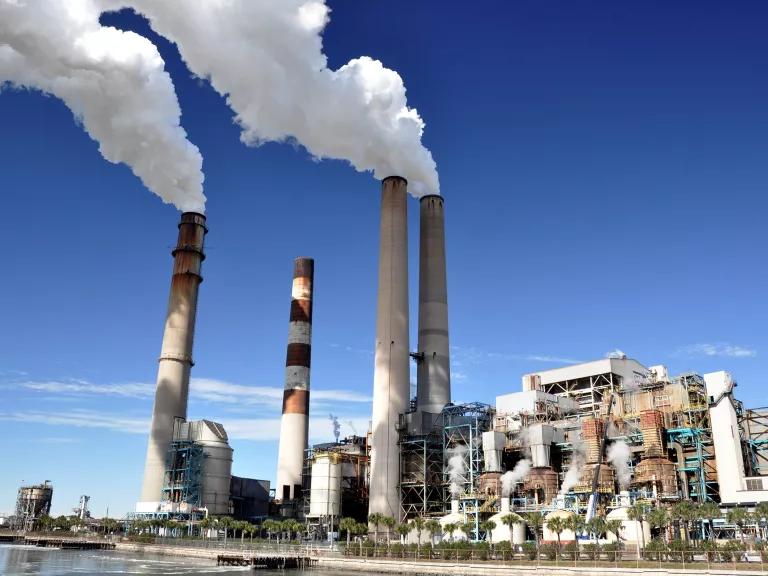
Big Bend Power Station, a coal-fired power plant in Tampa, Florida
Walter via Flickr
Where do greenhouse gases come from?
According to the Intergovernmental Panel on Climate Change (IPCC), the burning of fossil fuels for electricity and transportation, as well as land use patterns and agriculture, and industrial processes drive nearly all human-caused, or anthropogenic, greenhouse gas emissions.
Electricity and heat production
The IPCC's Fifth Assessment Report states that the burning of coal, oil, and gas to produce electricity and heat accounts for one-quarter of worldwide human-driven emissions, making it the largest single source. In the United States, according to EPA data, it’s the second-largest (behind transportation), responsible for about 28 percent of U.S. emissions in 2021, with carbon dioxide as the primary gas released, along with small amounts of methane and nitrous oxide.
Agriculture and land use
About another quarter of global greenhouse gas emissions stem from agriculture and other land uses, like deforestation, says the IPCC. In the United States, agricultural activities—primarily the raising of livestock and crops for food—accounted for 10 percent of greenhouse gas emissions in 2021. Of those, the vast majority were methane (which is produced as manure decomposes and as beef and dairy cows belch and pass gas) and nitrous oxide (often released with the use of nitrogen-heavy fertilizers).
Trees, plants, and soil absorb carbon dioxide from the air. The plants and trees do it via photosynthesis (a process by which they turn carbon dioxide into sugars that plants need to grow); the soil houses microbes that carbon binds to. So nonagricultural land use activities such as deforestation, reforestation (replanting in existing forested areas), and afforestation (creating new forested areas) can either increase the amount of carbon in the atmosphere (as in the case of deforestation) or decrease it via absorption, removing more carbon dioxide from the air than is emitted. When trees or plants are cut down, they no longer absorb carbon dioxide, and when they are burned as biomass or decompose, they release carbon dioxide back into the atmosphere. In the United States, land use activities currently represent a net carbon sink, absorbing more carbon dioxide from the air than they emit.
Industry
According to the IPCC, about one-fifth of global human-driven emissions come from the industrial sector, which includes the manufacturing of goods and raw materials (like cement and steel), food processing, and construction. In 2021, industry accounted for 23 percent of U.S. man-made emissions, of which the majority was carbon dioxide, although methane, nitrous oxide, and fluorinated gases were also released.

Jingying Zhao/Getty
Transportation
The burning of petroleum-based fuels, namely gasoline and diesel, to power the world’s transportation systems accounts for 14 percent of global greenhouse gas emissions, as noted in the IPCC's Fifth Assessment Report. In the United States, transportation is the largest contributor of greenhouse gases. (It accounted for 28 percent of U.S. emissions in 2021, according to the EPA.) Carbon dioxide is the primary gas emitted, though fuel combustion also releases small amounts of methane and nitrous oxide, and vehicle air-conditioning and refrigerated transport release fluorinated gases too.
Nationwide, cars and trucks are responsible for more than half of the transportation-related carbon emissions.
Buildings
Operating buildings generates 6.4 percent of global greenhouse gases, says the IPCC. In the United States, homes and businesses account for about 13 percent of warming emissions, says the EPA. These emissions, made up mostly of carbon dioxide and methane, stem primarily from burning natural gas and oil for heating and cooking, though other sources include leaking refrigerants (fluorinated gases) from air-conditioning and refrigeration systems and the management of waste and wastewater. (These direct emissions do not including the indirect emissions discussed above, like those tied to electricity—power for cooling, lighting, running appliances, and more—as well as emissions from building construction.)
Other sources
This category includes emissions from energy-related activities other than fossil fuel combustion, such as the extraction, refining, processing, and transportation of oil, gas, and coal. Globally, according to the IPCC, this sector accounts for 9.6 percent of emissions.
Greenhouse gas emissions by country
Since 1750, nearly 1.5 trillion tons of carbon dioxide have been released into the atmosphere by human activities. Cumulatively, no country has emitted more carbon dioxide than the United States—approximately 25 percent of the global total—with the European Union and United Kingdom (EU-28) just behind it. China is responsible for around 15 percent of the cumulative global total, but currently emits more carbon dioxide annually than any other country (31 percent). Together, the major economies of China, the United States (14 percent), the EU-28 (8 percent), India (7 percent), and Russia (5 percent) represent almost 65 percent of annual global emissions. Today and historically, African countries and small island nations, some of the regions most vulnerable to the harsh impacts of climate change, contribute the least.
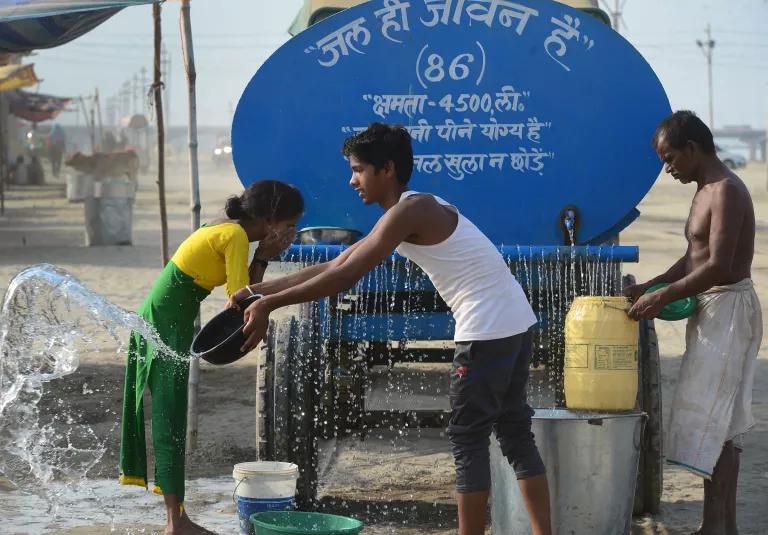
People receive water from a tanker on a hot day in Prayagraj, India.
Sanjay Kanojia/AFP/Getty
The consequences of the greenhouse effect
Today, concentrations of human-caused greenhouse gases in the atmosphere are higher than ever and the planet is heating up. Between preindustrial times and now, says the IPCC, the earth’s average temperature has increased almost 2 degrees Fahrenheit (1.1 degree Celsius), with two-thirds of that warming occurring in the last handful of decades alone.
According to the IPCC, the world can emit a total of just 400 billion tonnes more of carbon dioxide, measured from the start of 2020, if we want at least a 50 percent chance of staying below the critical threshold of 1.5 degrees Celsius (2.7 degrees Fahrenheit) of warming. At our current pace, the world will blow its entire “carbon budget” by around 2030.
Driven by the burning of fossil fuels, global warming is altering the earth’s climate systems in many ways, such as:
- Causing more frequent and/or intense extreme weather events, including heat waves, hurricanes, droughts, and floods.
- Exacerbating precipitation extremes, making wet regions wetter and dry regions drier.
- Raising sea levels, due to melting ice sheets and glaciers and an increase in ocean temperatures (warmer water expands, which can contribute to sea level rise).
- Altering ecosystems and natural habitats; shifting animals’ geographic ranges, seasonal activities, and migration patterns.
Climate change impacts where we can live, how we work, how we grow our food—especially if we live or work in frontline communities. Warmer temperatures mean more insects that spread diseases like dengue fever—and heat waves are getting hotter and becoming more lethal to humans. Climate change-driven droughts and floods also pose huge risks to agriculture. Research suggests that for every degree Celsius that the planet heats up, crop yields will go down 3 to 7 percent. Food insecurity can lead to mass human migration and political instability in regions all over the world.
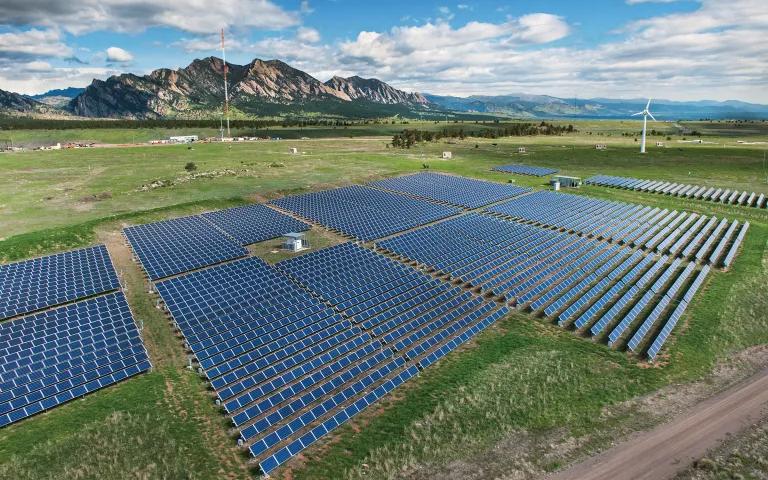
A solar array and wind turbine at the National Wind Technology Center near Boulder, Colorado
Dennis Schroeder/NREL
Solutions for reducing greenhouse gas emissions
The earth has always experienced warm and cool phases, with natural forces—from the sun’s intensity, volcanic eruptions, and natural changes in greenhouse gas concentrations—affecting how much energy from the sun our planet absorbs. As recently as a couple of centuries ago, the planet underwent a “Little Ice Age,” caused by a decrease in solar activity and an increase in volcanic activity. But today’s warming—particularly the increase in temperatures since the mid-20th century—is occurring at a pace that can’t be explained by natural causes alone.
The good news is that we have the ability to rein in runaway greenhouse gas emissions. But overhauling our energy systems will require transformative, aggressive global action—right now. According to the IPCC, we must halve greenhouse gas pollution by 2030 and reach net-zero emissions by 2050.
Reducing our greenhouse gas emissions will require significant effort at the international, national, and local levels. First and foremost, we must slash fossil fuel production, consumption, and pollution by ramping up our use of clean, renewable energy and energy-efficient technologies and by investing in fuel-efficient and electric vehicles.
We must end fossil fuel subsidies and better leverage investments, like those in the Inflation Reduction Act, to target clean energy technology and accessibility while reducing household energy bills, creating jobs, and protecting our health and environment. We must protect our carbon-storing forests and reduce food waste and the emissions that go with it. We should be doubling down on reducing emissions from dirty power plants and cars and trucks. And as individuals, we must commit to taking carbon-cutting actions in our daily lives.
It’s clear that decision makers, companies, leaders, and activists across the country and around the world staunchly believe we must all act on climate change. For just as the greenhouse gas emissions from a century ago are inducing the climate change we see now, the emissions we release today will impact us long into the future.
This story was originally published on July 16, 2019, and has been updated with new information and links.
This NRDC.org story is available for online republication by news media outlets or nonprofits under these conditions: The writer(s) must be credited with a byline; you must note prominently that the story was originally published by NRDC.org and link to the original; the story cannot be edited (beyond simple things such as grammar); you can’t resell the story in any form or grant republishing rights to other outlets; you can’t republish our material wholesale or automatically—you need to select stories individually; you can’t republish the photos or graphics on our site without specific permission; you should drop us a note to let us know when you’ve used one of our stories.
We need climate action to be a top priority in Washington.
Tell President Biden and Congress to slash climate pollution and reduce our dependence on fossil fuels.


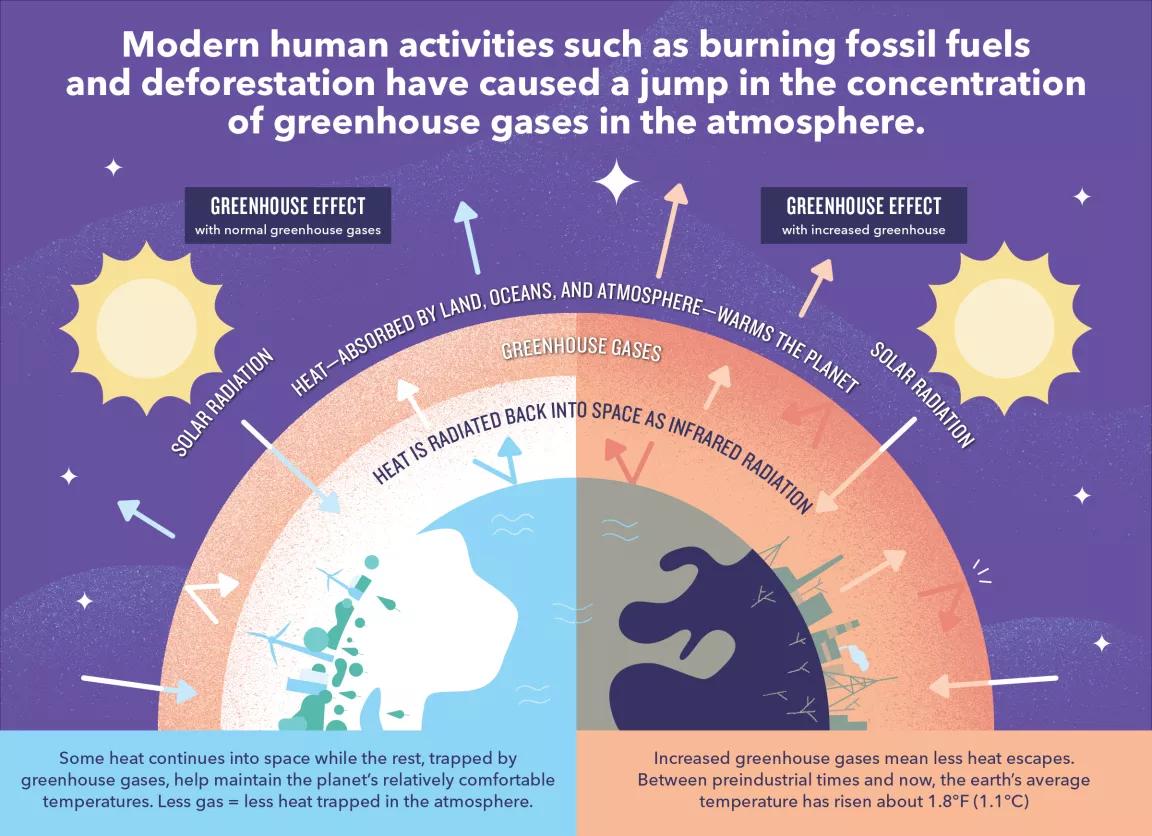
What Are the Causes of Climate Change?
What Are the Solutions to Climate Change?
Failing to Meet Our Climate Goals Is Not an Option